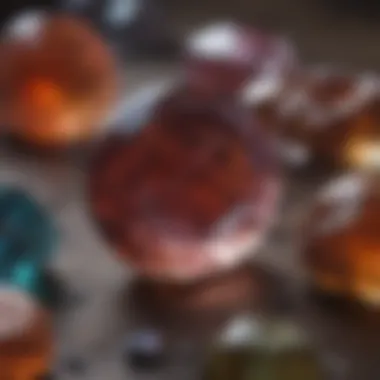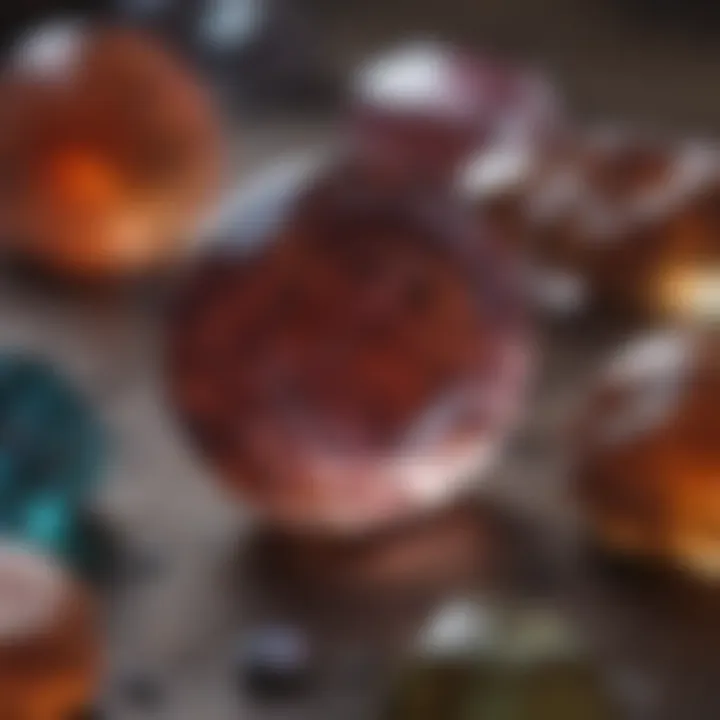Exploring the Best Rock: A Comprehensive Guide


Intro
Rocks are more than just inert matter on the Earth's surface. They are a fascinating element of our environment, acting as the planet's crust and serving various roles in ecological systems. Within the realm of geology, the diversity of rocks offers insights into the Earth's history, the processes that shape our landscape, and even the interactions between different environmental factors.
For rock and fossil collectors, understanding the different types of rocks is essential. The world of rocks is classified into three primary categories: igneous, sedimentary, and metamorphic. Each of these categories presents unique properties, formation processes, and uses. This guide aims to dissect these categories thoroughly, elevating your knowledge beyond the superficial.
From tricks to help identify different types for clarity in their collection, to the critical aspects of preservation techniques, this guide accommodates both the novice collector and the seasoned enthusiast. Each section will delve into properties, practical application, and the cultural relevance of numerous rock types.
Featured Collectible of the Month
Overview
Each month, a specific type of rock can be spotlighted as a collectible. This month's featured collectible is the Amethyst. Known for its striking purple hue, Amethyst is a variety of quartz and has been treasured throughout history, both for its beauty and supposed healing properties.
Historical Significance
Amethyst has long been associated with spirituality and protection. Ancient Greek cultures believed it could prevent intoxication and its name even derives from the Greek word "amethystos," meaning "not intoxicated." In medieval Europe, it was used in ecclesiastical jewelry, symbolizing piety and commitment. Collectors value Amethyst not only for its stunning appearance but also for its rich heritage in different cultures.
Identification Techniques
Visual Characteristics
To effectively identify rocks, it is essential to understand their visual characteristics. For instance, a well-formed Amethyst crystal stands out due to its hexagonal shape and vibrant purple color. Features such as texture, luster, and hardness are also critical in differentiating types of rocks. Learning to spot these characteristics can enhance one’s ability to recognize and appreciate diverse specimens.
Resources for Identification
Several resources are available for rock identification, including:
- Books on mineralogy and geology offer comprehensive information.
- Online forums, like Reddit, provide communities for collectors to share their findings and seek advice.
- Apps and websites like those found on Wikipedia and Britannica serve as reliable references for basic information.
These resources are beneficial for both amateur and serious collectors, fostering a community that encourages exploration and learning.
"Understanding the properties of rocks not only deepens appreciation but enhances the collecting experience."
As we continue through this guide, expect to find a blend of practical knowledge and engaging insights, all aimed at fostering a greater understanding of the rock world.
Intro to Rocks
Understanding rocks is fundamental for both geological study and practical applications. This section provides a foundational overview of what rocks are and discusses their significance in various fields. Rocks serve as the building blocks of our planet and influence everything from landscape formation to resource availability. By examining their properties and classifications, we set the stage for a deeper exploration into the fascinating world of geology.
Defining Rocks
Rocks are solid aggregates composed of one or more minerals or mineraloids. They vary widely in composition, texture, and color. The distinctions among different types of rocks arise from their origins, whether they form through volcanic activity, sedimentation, or metamorphosis.
To categorize rocks effectively, geologists often utilize three main classifications: igneous, sedimentary, and metamorphic. Each type has unique characteristics that reflect the processes that formed them.
- Igneous Rocks: These result from the cooling and solidification of molten material. They can be further divided into intrusive and extrusive rocks based on where they form.
- Sedimentary Rocks: Formed from the accumulation of sediments over time, these rocks can contain fossils and offer important insights into Earth’s history.
- Metamorphic Rocks: These arise from existing rocks that undergo transformation due to heat, pressure, or chemically active fluids.
The Importance of Rocks in Earth Sciences
Rocks play a vital role in understanding our planet's history and structure. They record changes in the Earth’s environment and provide clues about past climates and biological processes. The study of rocks can help explain geological events like earthquakes, volcanic eruptions, or the formation of mountain ranges.
Moreover, rocks are essential in various fields, such as:
- Construction: Many rocks are used as building materials. For instance, granite is often employed for countertops and buildings due to its durability.
- Natural Resources: Rocks can yield valuable minerals and fossil fuels. For example, coal, a sedimentary rock, is a primary energy source worldwide.
- Education and Research: The study of rocks enriches our understanding of natural history and aids in environmental monitoring and management.
"Rocks are more than just objects; they are the storytellers of Earth's past and present, holding invaluable information."
By exploring rocks, we not only enhance our comprehension of geological processes but also appreciate their significance in our daily lives and the natural environment.
Classification of Rocks
The classification of rocks is an essential foundation for understanding their characteristics, formation processes, and applications. This section serves to categorize rocks into three primary types: igneous, sedimentary, and metamorphic. Each category presents unique features that are significant for both geological study and rock collecting. Knowing how to classify rocks allows enthusiasts and educators to communicate effectively about their findings. Moreover, it aids in grounding practical applications in the field of geology.
Igneous Rocks
Types of Igneous Rocks
Igneous rocks are formed from the solidification of molten material known as magma or lava. There are two primary types of igneous rocks: intrusive and extrusive. Intrusive igneous rocks form within the Earth when magma cools slowly. This type allows for the growth of large crystals, making rocks like granite visually striking and often used in countertops and buildings because of their durability.
On the other hand, extrusive igneous rocks emerge when lava erupts onto the surface. Fast cooling often produces smaller crystals. Basalt, a common extrusive rock, is significant due to its vast presence across volcanic regions and its use in road construction. Understanding these types of igneous rocks is beneficial for collectors who appreciate their rarity and the geological processes that create them.
Formation Processes
The formation processes of igneous rocks involve significant geological activity. When magma rises to the surface, it can cool into various rock types depending on the environment and history of that magma. Plutonic processes refer to the slow cooling of magma beneath the Earth’s crust. These processes create large-grained rocks like diorite. Conversely, volcanic processes occur when lava erupts and cools quickly, forming fine-grained rocks such as pumice.
The primary characteristic of these formation processes is their dependency on temperature and pressure conditions. This knowledge is crucial for solidifying the understanding of how different igneous rocks appear. It opens avenues for exploration in terms of geological tours, as well as for collectors focused on acquiring unique specimens derived from varied conditions.
Sedimentary Rocks
Features of Sedimentary Rocks
Sedimentary rocks are typically layered, forming from the accumulation of sediments over time. Key features include stratification, which entails visible layers that reveal the history of the rock formation. This characteristic makes sedimentary rocks informative about past environments and geological events.


Among the notable types are limestone, which often contains fossils, and sandstone, recognized for its granular texture. These features make sedimentary rocks appealing for both study and collection. They usually signify some form of biological activity or ancient environmental conditions. Therefore, they are indispensable for those pursuing a deeper understanding of Earth's history and for collectors seeking aesthetically unique specimens.
Fossil Presence
Fossil presence is a distinct aspect of sedimentary rocks. These fossils develop when organic materials are buried and preserved within sediment layers over time. Fossils can usually be found in rocks such as shale and limestone. Their existence provides invaluable insights into past life forms and environmental conditions.
The significance of fossil presence lies in its ability to tell a story. Fossils support the study of paleontology, aiding in understanding extinct species and ancient ecosystems. This characteristic makes fossils a desirable feature for collectors aiming to enrich their collections with historically significant items. However, ethical considerations must be taken into account when collecting fossils since many are protected by law.
Metamorphic Rocks
Characteristics of Metamorphic Rocks
Metamorphic rocks arise from existing rocks that undergo a transformation due to heat, pressure, or chemically active fluids. Common examples are schist and gneiss, which feature pronounced foliation—a layered appearance caused by the alignment of minerals under stress. Metamorphic rocks are valued for their diversity and aesthetic appeal.
The primary characteristic of metamorphic rocks is rotational alignment, differentiating them from both igneous and sedimentary types. This quality appeals to collectors and geologists because it highlights the conditions under which those rocks were formed, including the significant forces of nature that sculpted them over geological time.
Metamorphism Factors
The factors influencing metamorphism include temperature, pressure, and the presence of fluids. An increase in temperature can cause the minerals within a rock to metamorphose, while pressure alters its physical structure. Additionally, hydrothermal fluid can facilitate chemical reactions that result in new minerals forming. Understanding these factors contributes to the overall picture of Earth's geological processes.
Awareness of these influences is advantageous for collectors who aim to preserve the integrity of their specimens while also seeking to understand the environment from which the rocks originated. The interplay among these factors creates diverse metamorphic rocks, making this knowledge a valuable resource for both geological study and collection.
Geological Processes and Rock Formation
Understanding geological processes is crucial to grasp how rocks are formed, altered, and recycled in various natural environments. These processes not only explain the journey rocks undertake through time but also highlight their significance to Earth’s landscape and, by extension, to human life. When discussing geological processes, it’s important to consider the interplay of various factors that influence rock formation, including temperature, pressure, and the chemical environment.
The Rock Cycle
The rock cycle is a fundamental concept that illustrates the dynamic processes that form and transform rocks within the Earth’s crust. It is an ongoing cycle where igneous, sedimentary, and metamorphic rocks are continuously broken down and reformed over time. Understanding this cycle allows collectors and enthusiasts to appreciate the complexity of their specimens.
- Igneous rocks form from the solidification of molten material, either magma below the surface or lava exposed to the atmosphere.
- Sedimentary rocks arise from the accumulation and compaction of mineral and organic particles. They often contain fossils, revealing Earth's history.
- Metamorphic rocks result from the transformation of existing rocks due to elevated temperature and pressure, altering their mineral composition.
Observing how a rock can shift from one type to another emphasizes the continuously evolving nature of geological materials.
Weathering and Erosion
Weathering and erosion are vital processes in rock formation, acting as powerful agents of change. Weathering breaks down rocks into smaller particles, influenced by physical, chemical, and biological factors. For instance:
- Physical weathering involves temperature fluctuations leading to cracking.
- Chemical weathering alters mineral structure through reactions with water or air.
- Biological weathering includes actions of plants and animals.
Erosion, on the other hand, involves the transportation of these weathered materials by water, wind, or ice. Over time, this movement shapes the landscape and redistributes rock materials, contributing to sedimentary rock formation. Collectors should understand these processes to assess the origins and history of the rocks in their collections.
Plate Tectonics and Rock Formation
Plate tectonics plays a crucial role in the formation and alteration of rocks. The movement of Earth's tectonic plates can lead to several geological phenomena. For example:
- Subduction occurs when one plate moves under another, often resulting in increased pressure and temperature conditions suitable for metamorphism.
- Rift zones create conditions for the formation of igneous rocks as magma rises to the surface, forming new crust.
These tectonic activities not only lead to the creation of various rock types but also generate earthquakes and volcanic eruptions that can dramatically reshape the Earth’s surface. Understanding these processes helps collectors comprehend where their rocks originated and the history behind their formation.
The intricate relationships among geological processes, rock types, and the Earth's landscape provide a context for the value and significance of rocks in both scientific and personal collections.
By analyzing these geological processes, we can foster a deeper appreciation for rocks, enhancing our understanding of Earth’s history and the materials we collect.
Identifying Rocks
Identifying rocks is an essential skill for collectors and enthusiasts alike. It allows individuals to understand the variety of rocks in nature and appreciate their unique properties. Through identifying rocks, one gains insight into their origins, compositions, and how they fit into the larger geological context. This section focuses on the critical aspects of identifying rocks based on their physical properties and the tools that facilitate the process.
Physical Properties
Physical properties serve as the foundation for rock identification. They include color, texture, and hardness. Each property provides insight into the rock's formation and usage.
Color
Color is often the first characteristic that catches the eye when observing a rock. It can reflect the mineral composition and helps in distinguishing between rock types. For instance, a rock rich in iron may appear reddish, while one containing high levels of quartz generally appears lighter. Understanding color is beneficial because it simplifies the identification process.
However, color alone can be deceptive. Environmental factors like weathering can alter a rock's original hue. One must consider rareness of certain colors, helping identify unique specimens. The ability to discern colors accurately can also aid in understanding geological history, as it relates to the conditions of formation.
Texture
Texture refers to the size, shape, and distribution of mineral grains within a rock. It is a critical identifying element, distinguishing between igneous, sedimentary, and metamorphic rocks. For instance, igneous rocks can have a glassy texture if they cool quickly, while sedimentary rocks often exhibit a layered texture due to deposition.
The key benefit of analyzing texture lies in its ability to reveal the processes that shaped the rock. Rocks with a fine texture suggest rapid cooling, while coarse textures indicate longer cooling periods. Recognizing textures can enhance the collector's understanding of rock formation and yuield valuable information about their history.
Hardness
Hardness, described by the Mohs scale, measures a rock's resistance to scratching. This property is particularly useful in distinguishing between materials. For example, quartz is a relatively hard mineral, ranking a seven, which helps to differentiate it from softer minerals like calcite, which ranks at three.
Understanding hardness is advantageous in practical applications. Harder rocks are typically more durable, making them suitable for certain industrial uses. However, collectors must be cautious, as harder rocks may be more challenging to work with during identification. Choosing the right techniques is key to minimizing damage while exploring various specimens.
Using Tools for Identification
To facilitate rock identification, various tools can be employed. These tools enhance the accuracy of observations, making it easier for collectors to categorize their findings.
Hand Lens


A hand lens is an essential tool for examining rocks up close. It provides magnification, allowing collectors to observe details that are otherwise invisible to the naked eye. The key characteristic of a hand lens is its portability; it can be easily carried during field explorations.
Using a hand lens enables collectors to examine crystal structures, surface characteristics, and mineral composition. The unique advantage of this tool is that it fosters a deeper understanding of rocks, facilitating accurate identification in the field. However, it also requires practice to interpret what is observed keenly.
Field Guides
Field guides are crucial resources for rock identification. They offer illustrations, descriptions, and instructions on recognizing various rock types and minerals. A comprehensive field guide serves as an invaluable reference for both new and experienced collectors.
The primary benefit of using a field guide is the consolidated information it presents. It is designed to be user-friendly, allowing collectors to quickly access relevant data. Nonetheless, relying solely on a field guide may limit hands-on experience. It is important for collectors to combine guidebook knowledge with practical identification skills to build expertise.
Rocks in Collecting
Collecting rocks is a pursuit that merges passion with education. For many enthusiasts and collectors, rocks tell stories about the Earth’s history as well as their personal journeys. Understanding the topic of rocks in collecting is vital as it opens up avenues for deeper appreciation and knowledge. Collectors engage not only with the physical characteristics of rocks but also with their geological backgrounds and cultural implications. It is an evolving hobby that encourages careful examination and respect for natural resources.
Building a Rock Collection
Choosing Your Focus
When you start collecting rocks, choosing your focus is essential. This decision significantly impacts the direction and depth of your collection. Focusing on a specific type of rock, such as igneous or sedimentary, allows collectors to gain expertise in certain areas. It can lead to a more organized collection, making it easy to expand over time.
A key characteristic of selecting a focus is that it can align with personal interests. Some may prefer rare gemstones, while others enjoy common minerals. This focused approach provides clarity and purpose.
However, it is important to consider the advantages and disadvantages. While a narrow focus can enrich knowledge, it might limit variety. Finding a balance is key.
Ethical Collecting Practices
Ethical collecting practices are a crucial aspect in the realm of rock collecting. This involves gathering rocks in a manner that does not harm the environment or deplete local resources. Ethical practices promote sustainability and respect for geological formations. By adhering to these guidelines, collectors contribute positively to the understanding and appreciation of the Earth's features.
A main benefit of ethical collecting is that it fosters a sense of responsibility among enthusiasts. This approach educates collectors about their impact on nature and encourages conservation. Yet, the unique challenge lies in identifying what constitutes ethical behavior, especially in diverse regions with different regulations. Gradually, a responsible collector develops an understanding of how to navigate these considerations.
Displaying Your Collection
Best Practices in Display
Display methods can greatly enhance the visibility and appeal of a rock collection. Proper display helps highlight the unique characteristics of each specimen, making it enjoyable for both the collector and viewers. This practice also serves an educational purpose, allowing observers to appreciate the details of each rock.
A critical aspect of best practices is the use of appropriate materials and locations for display. Choosing cases made from glass can protect rocks from dust while allowing light to enhance their colors. Using labels with essential information about each specimen adds educational value.
However, collectors must be mindful of potential drawbacks. Poor lighting or overcrowded displays can detract from the overall presentation. Thoughtful planning in display contributes significantly to the enjoyment of the collection.
Avoiding Damage
Protecting the integrity of rocks is an ongoing concern for collectors. Avoiding damage is essential to ensure that specimens remain in excellent condition. This involves careful handling, storage, and display techniques.
A defining feature of avoiding damage is the awareness of the specific vulnerabilities of each rock type. Some rocks may be more prone to scratching or fading in sunlight. Being knowledgeable about these traits can save collectors from costly mistakes.
The advantages of avoiding damage are quite clear: it preserves the collection’s value while prolonging the life of each specimen. On the other hand, there can be a learning curve associated with this, as not all collectors initially recognize the best practices for care.
"Caring for your collection is as important as acquiring it. Both require dedication and knowledge."
Cultural Significance of Rocks
Understanding the cultural significance of rocks can reveal much about human history and our relationship with the environment. Rocks are inherent to various aspects of cultures worldwide. From ancient civilizations to contemporary societies, rocks have been utilized in many ways. This section digs into their historical uses and symbolic meanings, providing a lens to view rocks beyond their geological properties.
Historical Uses of Rocks
Building Materials
Rocks have always been essential in construction. Ancient structures like the pyramids of Giza and the Roman Colosseum illustrate the durability and strength of stone as a building material. One key characteristic of building materials made from rocks is their longevity. Unlike modern materials, these stones can endure the test of time, standing firm against weathering and erosion.
The unique feature of building materials such as granite and limestone lies in their natural aesthetic appeal. These stones provide not only structural integrity but also visual beauty, making them a popular choice for architectural elegance and landscape design. However, the extraction of these materials can lead to environmental concerns, emphasizing the need for sustainable practices in their use.
Tools and Weapons
Historically, rocks have played a vital role in tool and weapon production. Early humans crafted tools from flint and obsidian due to their sharp edges, enhancing hunting and survival skills. The key characteristic of these tools was effectiveness. Their ability to be shaped into various forms made them invaluable for daily tasks in prehistoric times.
The unique feature of stone tools lies in their versatility. They could be used for cutting, scraping, and even as projectile weapons. However, modern technologies have largely replaced these primitive tools, creating a disconnect from this essential aspect of human development. Despite this, understanding these ancient practices can enrich contemporary perspectives on human ingenuity and adaptation.
Rocks in Art and Symbolism
Cultural Artifacts
Rocks are not just practical; they also serve aesthetic and cultural purposes. Cultural artifacts crafted from stones often carry historical significance, reflecting the values, beliefs, and practices of a society. The key characteristic of these artifacts is their connection to heritage. They embody stories and cultural narratives that can be passed down through generations.
Artifacts made of materials like marble or jade are particularly valued for their beauty and craftsmanship. Their unique feature lies in the way they can represent status, belief systems, or artistic expression within cultures. In contrast, the challenge of preserving these artifacts emphasizes the need for careful handling and protective measures to ensure their longevity in collections and museums.
Symbolic Meanings
Rocks hold profound symbolic meanings across various cultures. For many, they represent stability, strength, and endurance. The key characteristic of these symbols is their ability to convey deep philosophical meanings. For example, some indigenous cultures regard certain rocks as sacred, intertwining them with their spiritual beliefs and practices.
The unique feature of symbolic meanings attached to rocks is that they vary dramatically between cultures and historical contexts. However, while these meanings enrich cultural narratives, they can also lead to misunderstandings among differing cultural perspectives. Recognizing these dynamics promotes a deeper appreciation for both the culture and the rocks that embody their beliefs.
"Rocks are silent witnesses to human history, providing insights into the past that can shape our understanding and appreciation of the present and future."
This exploration of cultural significance highlights how rocks influence human life far beyond mere geological contexts. Engaging with this narrative helps collectors and enthusiasts appreciate their rocks not just as physical objects, but as rich tapestries woven into the fabric of human culture.


Care and Preservation of Rocks
Caring and preserving rocks is essential for both collectors and enthusiasts. Proper care ensures the longevity of these natural treasures. This topic mainly focuses on cleaning techniques and storage solutions, which are crucial for maintaining both appearance and structural integrity. When rocks are well maintained, they often retain their aesthetic appeal and scientific value. Care practices can help prevent damage caused by environmental factors or mishandling.
With a deeper understanding of care methods, collectors can make informed choices about preserving their collections. This guide emphasizes a balance between preservation and enjoyment, with methods to maintain aesthetics without compromising the integrity of the rocks themselves.
Cleaning Techniques
Cleaning rocks properly is vital to preserve their physical characteristics. Common cleaning methods include brushing, soaking, or using mild solutions. Each rock may require a specific approach depending on its composition and condition. For instance, softer stones, like sandstone, may need more gentle treatment to avoid scratching their surfaces.
Using a soft-bristled brush allows removal of dust, dirt, and other debris without causing scratches. Soaking rocks in warm soapy water can effectively loosen stubborn grime. Just remember to avoid harsh chemicals that may damage the rock. Ensuring that stones are completely dry before storage can also help to prevent any potential mold growth.
Storage Solutions
Proper storage is crucial to maintaining a rock collection. Effective storage methods help reduce exposure to harmful conditions. They also prevent accidental damage due to handling or environmental changes.
Protective Cases
Protective cases serve as an excellent option for storing valuable rocks. They provide a physical barrier against external elements. Glass cases often showcase the beauty of the rocks while ensuring visibility. Many collectors prefer cases with UV protection to minimize fading. This aspect is important as some rocks may lose color over time when exposed to light.
A unique feature of protective cases is that they can be customized according to the shape and size of the rocks. This allows maximum protection while highlighting their natural beauty. However, one disadvantage is the cost; high-quality cases can be expensive. Despite this, the investment is often worth the extra care given to precious specimens in a collector's collection.
Climate Control
Climate control is another important consideration in rock preservation. Maintaining a consistent temperature and humidity level helps prevent cracking or fading. For example, excessive moisture may lead to mold, while extreme dryness can cause physical breaks in some rocks. It is typically beneficial to store them in a controlled environment that mimics their natural surroundings.
A unique feature of climate control is the use of dehumidifiers or humidifiers to achieve the desired balance. While these tools offer significant advantages, they can require regular maintenance and monitoring, which some collectors may find cumbersome.
Effective care and preservation is not just about beauty; it's about honoring the geological history behind each specimen.
Being attentive to details in cleaning and storing rocks yields greater enjoyment and appreciation for these natural wonders. With the right techniques, collectors can ensure that their rocks remain in pristine condition. Proper care will ultimately amplify both educational and aesthetic values in any collection.
Exploring Rare Rocks
Exploring the category of rare rocks is essential for anyone invested in geology and rock collecting. Rare rocks offer not only aesthetic appeal but also a glimpse into the Earth's history and processes. Their unique formation conditions make them intriguing and valuable to both collectors and scientists. Understanding these rare specimens can enhance knowledge about geological diversity and ecological systems. Furthermore, rare rocks often have specific cultural, historical, and scientific significance. This section will delve into the types of rare rocks and the best locations for discovering them.
Types of Rare Rocks
Rare rocks can be classified into several types, each with distinct characteristics and formation processes. Some notable categories include:
- Obsidian: A naturally occurring volcanic glass, obsidian is prized for its sharp edges and beautiful luster. It occurs in various colors, including black, green, and brown.
- Petrified Wood: This fossilized tree trunk or branch has undergone a process where organic material is replaced with minerals, preserving the wood structure while providing unique patterns.
- Meteorites: Fragments from outer space that have landed on Earth, meteorites are highly sought after, especially those that come from the Moon or Mars.
- Benitoite: Known as California's state gem, benitoite is a rare blue barium titanate that can only be found in a limited region of California.
- Alexandrite: A color-changing variety of the mineral chrysoberyl, it is notably rare and can transform its color under different lighting, adding to its allure.
Each type of rare rock presents its own set of collecting challenges and rewards. Collecting rare rocks involves more than just aesthetics; it often includes an understanding of geology and the conditions under which these rocks were formed.
Where to Find Rare Rocks
Finding rare rocks requires specific knowledge and often some travel to well-known locales. Natural deposits of rare minerals may not be found everywhere. Some prime locations include:
- California: Famous for benitoite and a variety of unique minerals, collectors often explore the San Benito County area.
- Arizona: Known for its rich mineral deposits, Arizona is home to various rare crystals, including azurite and malachite.
- Greenland: This place has become a focal point for collectors looking for meteorites and unique geological samples.
- Scotland: Certain highland regions contain some of the rarest igneous rocks that are sought after by collectors.
- Northwest Territories of Canada: Known for rare diamonds, collectors sometimes find other unique rocks in this expansive territory.
"Each discovery of a rare rock not only enriches a collection but also adds to the narrative of Earth's geological secrets."
Exploring these locations often requires paying attention to weather conditions, as well as adhering to local regulations regarding collection. The thrill of discovering a rare rock can be both rewarding and educational, making it a worthwhile endeavor for passionate collectors. Conducting thorough research and connecting with local rockhounding groups can greatly enhance the rock-hunting experience.
Modern Applications of Rocks
Rocks serve as more than mere geological components; they are pivotal to various modern applications that influence everyday life and industry. The applications of rocks are vast, covering a range of fields from construction to environmental sustainability. This section explores the significance of rocks in contemporary settings, their practical uses, and the benefits they bring to our society.
Industrial Uses
Rocks are essential in numerous industries, where their unique properties offer valuable tools and materials. In construction, rocks like granite, marble, and limestone are widely utilized due to their hardness and durability. These materials serve multiple purposes such as:
- Building materials: Granite and limestone provide strong, reliable foundations for buildings. They are also used in decorative elements, enhancing aesthetic appeal.
- Road construction: Aggregates derived from crushed rocks help in the creation of asphalt and concrete for roads, bridges, and other infrastructure.
- Mining and extraction: Certain rocks are mined for minerals and resources such as quartz, which is essential in the production of glass, and dolomite, which is used to produce cement.
The importance of these applications cannot be overstated, as they underpin much of the modern infrastructure that society relies on.
Rocks in Sustainability
The relevance of rocks extends into the realm of sustainability, where they play a crucial role in environmental initiatives. Here are several ways rocks contribute to sustainable practices:
- Natural filtration: Rocks, especially gravel and sand, are commonly used in water filtration systems. Their ability to filter out impurities makes them vital for clean drinking water.
- Carbon capture: Certain igneous rocks, like basalt, are being researched for their potential to absorb carbon dioxide from the atmosphere. This process could significantly mitigate greenhouse gas emissions, making it a promising avenue for tackling climate change.
- Soil health: Rocks can enhance soil quality by providing essential minerals and nutrients necessary for plant growth. This is particularly important in agriculture, where improving soil health is vital for food production.
The applications of rocks in sustainability not only help in environmental conservation but also encourage the responsible use of natural resources.
In summary, the modern applications of rocks reveal their indispensable role in both industrial needs and sustainability efforts. The diverse range of uses signifies a continuing relevance of rocks in a rapidly evolving world, where innovation is essential for progress.
The Future of Rock Collecting
As society progresses, the way people interact with rocks and minerals is evolving. This shift affects not only how collectors approach their passion but also how specific advances in technology and changing preferences shape the collecting landscape. The future of rock collecting is significant because it highlights the need for sustainability, education, and innovation in this niche interest.
Technological Advances
The impact of technology on rock collecting is multi-faceted. Tools and resources for collectors have significantly increased due to advancements in technology. For example, digital apps and websites can now provide detailed information about various rock types and their classifications. Mobile applications such as Rocks & Minerals and iStone allow collectors to identify rocks simply by taking a picture. Moreover, 3D printing technologies are becoming available. They enable collectors and hobbyists to create replicas of rare specimens for study or display.
In addition, advancements in scanning technology allow for non-destructive analysis of rock samples. Techniques such as X-ray diffraction and scanning electron microscopy give collectors detailed insight into the composition and structure of their rocks. These methods also enhance research accuracy.
Shifts in Collector Preferences
The preferences of rock collectors are undergoing significant changes. Younger generations show greater interest in unique specimens, particularly those with unusual colors or patterns. Social media platforms and online marketplaces facilitate these shifts by showcasing rare finds and expanding access to collectors around the world. Online forums, such as Reddit and Facebook groups, also serve as vital spaces for knowledge-sharing and community building.
As awareness of environmental concerns rises, sustainable and ethical collecting practices are becoming standard. Collectors are increasingly mindful of how and where they source their specimens. Interest in local geology is also growing, as collectors seek rocks from their own regions rather than exclusively exotic specimens.



